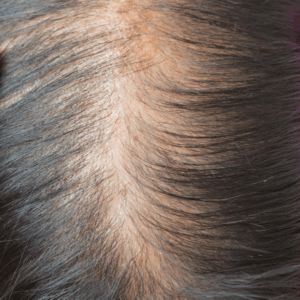 You notice more strands in the shower drain. Your part looks a little wider. Maybe your once-thick ponytail feels thinner in your hands. For women and men alike, this can be a shocking and emotional moment, and all too often, the explanation they hear is: “It’s just aging.”
You notice more strands in the shower drain. Your part looks a little wider. Maybe your once-thick ponytail feels thinner in your hands. For women and men alike, this can be a shocking and emotional moment, and all too often, the explanation they hear is: “It’s just aging.”
But that’s not the whole story.
Hair loss and thinning in midlife are incredibly common, but they are not inevitable. In fact, hair is often a visible barometer of what’s going on inside your body. Stress, shifting hormones, circulation changes, and even environmental toxins can all influence whether your follicles stay vibrant or slip into dormancy.
The good news? Dormant follicles aren’t dead. With the right support, they can often be revitalized, resulting in stronger, fuller, and healthier-looking hair.
In this article, we’ll explore the four hidden root causes of hair thinning in those over 40 (especially women), why many conventional solutions fall short, and how a gentle inside-out approach can make all the difference. We’ll also take a closer look at innovative botanical hair serums, like EverBella’s Essential Growth Hair Serum, that are designed to nourish your scalp environment and help support healthier growth naturally.
The 4 Hidden Causes of Midlife Hair Loss
Most people are told that thinning hair is “just aging” or “just genetics.” While those factors can play a role, they don’t explain the whole picture. The truth is, hair follicles respond dynamically to what’s happening inside your body and in your environment. And during midlife, when hormones shift and stress levels often climb, follicles are especially vulnerable.
Here are four root causes that many women have never been told about.
1. Inflammation: Stress, Sleep, and the Gut Axis
One of the most overlooked culprits in hair thinning is inflammation. Your body uses inflammation as a short-term healing response, but when it becomes chronic, it can wreak havoc, including on your scalp.
- Stress and cortisol: Chronic stress raises cortisol, which has been shown to push hair follicles prematurely into the telogen (resting) phase of the growth cycle. This leads to more shedding — sometimes noticeable in just a few months.
- Sleep deprivation: Poor sleep disrupts your circadian rhythm, which controls repair and growth signals. Without adequate deep sleep, your follicles don’t get the cues they need to regenerate.
- Gut health: Your gut and your hair are more connected than you might think. When the gut is imbalanced, nutrient absorption suffers. Deficiencies in hair-critical nutrients like biotin, zinc, and iron can follow. At the same time, leaky gut or dysbiosis can trigger systemic inflammation that further disrupts hair growth.
Together, stress, poor sleep, and gut imbalances form a “perfect storm” of inflammatory stress that weakens hair follicles and accelerates shedding.
2. Hormonal Shifts: Estrogen, Androgens, and Cortisol
 Hormones are powerful messengers for hair growth. Estrogen, in particular, has protective effects: it helps prolong the anagen (growth) phase of hair. That’s why many women notice their hair feels thicker and more lustrous during pregnancy, when estrogen is high.
Hormones are powerful messengers for hair growth. Estrogen, in particular, has protective effects: it helps prolong the anagen (growth) phase of hair. That’s why many women notice their hair feels thicker and more lustrous during pregnancy, when estrogen is high.
But in perimenopause and menopause, estrogen levels naturally decline. Without its balancing effect, androgens (male hormones that women also produce) can exert more influence. For women who are sensitive, this may mean follicles gradually shrink, producing finer, weaker strands or eventually stopping growth altogether.
Cortisol, the stress hormone, adds fuel to the fire by interfering with estrogen production and raising inflammation. The result: hair that feels thinner, weaker, and slower to grow.
3. Reduced Scalp Circulation
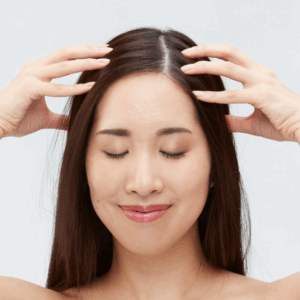 Your hair follicles are tiny but energy-hungry structures. To produce healthy strands, they require a steady supply of oxygen and nutrients via blood flow. As we age, circulation naturally declines, and stress, inactivity, or tension in the scalp can exacerbate the issue.
Your hair follicles are tiny but energy-hungry structures. To produce healthy strands, they require a steady supply of oxygen and nutrients via blood flow. As we age, circulation naturally declines, and stress, inactivity, or tension in the scalp can exacerbate the issue.
When circulation is sluggish, follicles are literally starved of the resources they need. This doesn’t kill them, but it can push them into dormancy, where they sit idle instead of producing hair.
The good news? Research shows that increasing scalp micro-circulation through massage, mechanical stimulation, or certain topical botanicals can help reawaken dormant follicles. That’s why scalp massage and circulation-supporting ingredients are cornerstones of more natural hair restoration approaches.
4. Toxin Load and Product Build-Up
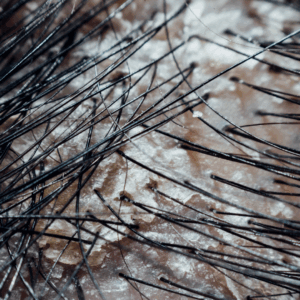 Your scalp is skin, and just like skin elsewhere on your body, it’s affected by the environment. Everyday exposure to air pollution, pesticides, and even endocrine-disrupting chemicals (EDCs) in personal care products can generate oxidative stress at the follicle level. Oxidative stress damages the delicate cells that keep hair growing strong.
Your scalp is skin, and just like skin elsewhere on your body, it’s affected by the environment. Everyday exposure to air pollution, pesticides, and even endocrine-disrupting chemicals (EDCs) in personal care products can generate oxidative stress at the follicle level. Oxidative stress damages the delicate cells that keep hair growing strong.
At the same time, many conventional hair products contain heavy silicones, sulfates, or preservatives. Over time, these can build up, smother the scalp, and disrupt the natural oil balance. Instead of nourishing follicles, they leave them stressed and struggling to thrive.
This doesn’t mean you need a perfectly “pure” lifestyle to have good hair. But reducing toxic load where you can, and choosing products that work with your scalp instead of against it, makes a noticeable difference.
The key takeaway: hair loss isn’t a surface problem. It’s a signal. Stress, hormones, circulation, and toxins all influence your scalp environment. When you address these root causes, you create the conditions for your follicles to reawaken and start growing stronger strands again.
Why Many Conventional Fixes Disappoint (and Sometimes Worsen Things)
When hair loss or thinning strikes, it’s natural to look for quick fixes. After all, the sight of extra strands in the shower drain or a widening part can feel urgent and distressing. Unfortunately, many of the most common “solutions” don’t address the true root causes of hair thinning, and in some cases, they can actually make things worse.
Treating Symptoms Instead of Systems
Conventional treatments often focus narrowly on the symptom (hair falling out) rather than the system (why the follicle is under stress in the first place). For example, products that promise to “thicken” hair instantly usually do so by coating the shaft with heavy silicones or polymers. This may give the appearance of fullness, but it does nothing to strengthen the follicle beneath the scalp. Worse, over time, these coatings can build up, suffocating the scalp and making it harder for new growth to emerge.
Harsh Ingredients That Backfire
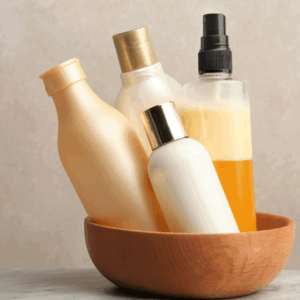 Many mainstream shampoos and treatments contain sulfates, parabens, synthetic fragrances, or preservatives. While these ingredients create foam or extend shelf life, they can strip the scalp of its natural oils, irritate sensitive skin, and disrupt the delicate microbiome of the scalp. An irritated scalp is an inflamed scalp — and inflammation is one of the key drivers of follicle weakness and shedding.
Many mainstream shampoos and treatments contain sulfates, parabens, synthetic fragrances, or preservatives. While these ingredients create foam or extend shelf life, they can strip the scalp of its natural oils, irritate sensitive skin, and disrupt the delicate microbiome of the scalp. An irritated scalp is an inflamed scalp — and inflammation is one of the key drivers of follicle weakness and shedding.
Invasive or Short-Term Approaches
For women who feel desperate, options like injections, implants, or harsh topical drugs may seem appealing. But while some can deliver short-term results, they often require ongoing maintenance, come with side effects, and fail to address underlying issues like stress, hormone shifts, or poor circulation. Without addressing those root causes, hair continues to weaken over time.
The Smother/Strip Cycle
A frustrating paradox is that many “solutions” create a cycle: heavy products smother follicles, leading to more thinning; harsh cleansers strip natural oils, leading to a stressed scalp; irritation leads to inflammation, which only accelerates the problem. Women end up spending more money chasing new products, while their hair feels thinner and more fragile.
The truth is, hair thrives when the environment of the scalp is calm, nourished, and supported. That’s why more and more experts are turning to approaches that work with the body’s natural systems, reducing inflammation, restoring balance, and nourishing the scalp directly with gentle, targeted support.
The Gentle Inside-Out Plan (Foundations You Can Start Now)
If there’s one thing to remember, it’s this: hair follicles are living tissue. They respond to the same stimuli as the rest of your body: nourishment, circulation, stress levels, hormones, and environmental factors. That means when you take care of your body as a whole, you’re also taking care of your hair.
Here’s a four-part foundation you can begin building today to create an internal and external environment that supports healthier growth.
1. Nutrition for Follicle Function
Your hair is made mostly of protein, specifically keratin, and requires a steady supply of nutrients to grow strong. Unfortunately, modern diets (and midlife absorption changes) often leave us lacking in key building blocks.
- Protein: Without enough dietary protein, your body will prioritize vital organs over hair. Aim for a palm-sized portion at meals (fish, poultry, legumes, tofu).
- Vitamin D: Deficiency is linked to hair shedding as it helps regulate the hair cycle.
- Iron & Zinc: Both are crucial for follicle metabolism and repair.
- Biotin & B vitamins: Support keratin production and energy at the follicle level.
- Omega-3 fatty acids: Help reduce inflammation and nourish cell membranes.
Tip: Focus on a colorful, whole-food diet and consider supplementation if you want to be sure you’re getting enough.
2. Stress Resilience Rituals
Stress isn’t just a mental weight. It shows up on your scalp. Elevated cortisol signals follicles to abandon their growth phase early, triggering more shedding. Managing stress is non-negotiable for hair health.
- Daily micro-practices: Just 10 minutes of breathwork, stretching, or meditation can dial cortisol down.
- Movement: Regular exercise increases circulation to the scalp and balances hormones.
- Nature time: Studies show even short walks outdoors lower stress hormones.
Small, consistent rituals matter more than dramatic lifestyle overhauls. Your follicles benefit from every moment you spend in a calmer state.
3. Sleep as a Growth Signal
 Think of sleep as your body’s nightly repair shop. During deep sleep, growth hormones are released that stimulate tissue repair, including in your hair follicles.
Think of sleep as your body’s nightly repair shop. During deep sleep, growth hormones are released that stimulate tissue repair, including in your hair follicles.
- Aim for 7–9 hours of quality rest.
- Create a sleep-friendly routine: dim lights in the evening, avoid screens, and stick to regular bedtimes.
- Nutrient helpers: magnesium glycinate, glycine, or tart cherry can support deeper sleep if needed.
Better sleep doesn’t just restore energy. It restores the cellular signals your follicles need to stay in the growth phase longer.
4. Scalp Care: “Healthy Soil for Healthier Strands”
Just like a plant won’t grow in depleted soil, hair won’t thrive on a neglected scalp. Treating the scalp as skin, worthy of care and nourishment, can transform hair health.
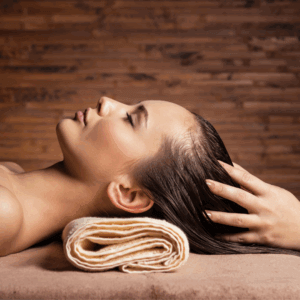 Gentle cleansing: Avoid harsh sulfates and choose shampoos that clean without stripping natural oils.
Gentle cleansing: Avoid harsh sulfates and choose shampoos that clean without stripping natural oils.- Scalp massage: Just 3–5 minutes daily boosts micro-circulation, delivering more nutrients and oxygen to follicles.
- Topical nourishment: Lightweight, botanical serums can help calm inflammation, improve circulation, and condition the follicle environment. (We’ll explore these in more detail in the next section.)
The key is consistency. Nutrition, stress management, sleep, and scalp care won’t change your hair overnight, but together, they lay a powerful foundation. And when paired with targeted support, like carefully formulated serums, they create the best possible conditions for your follicles to thrive.
Spotlight: How Botanical Hair Serums Support Healthier Growth
While nutrition, stress, and sleep lay the foundation for healthy hair, your scalp also benefits from direct, topical care. Think of it like tending to a garden: nourishing the soil from within matters, but so does watering and protecting it from the outside.
That’s where botanical hair serums come in. Unlike heavy styling products that simply coat the hair shaft, a well-formulated serum is designed to penetrate the scalp environment, supporting the follicle itself.
What a Good Serum Should Do
 A high-quality hair serum isn’t about “instant thickness.” It should:
A high-quality hair serum isn’t about “instant thickness.” It should:
- Promote circulation: Stimulate blood flow to the scalp, delivering oxygen and nutrients to follicles.
- Provide antioxidants: Reduce oxidative stress that can weaken or damage follicle cells.
- Calm the scalp: Balance oil production, soothe irritation, and create an optimal environment for growth.
- Protect strands: Hydrate and condition the hair shaft to reduce breakage while new growth establishes.
When these elements come together, a serum helps keep follicles active longer, the key to fuller, stronger hair over time.
Botanical Ingredients That Matter
Not all serums are created equal. Some rely on synthetic chemicals or heavy oils that can clog follicles. Others, however, use lightweight, plant-based ingredients backed by tradition and science:
- Rosemary oil: Known to increase micro-circulation. In studies, it has performed comparably to conventional treatments for certain types of hair loss, without harsh side effects.
- Peppermint oil: Creates a cooling sensation that signals increased blood flow. Research suggests it may help extend the growth phase of hair.
- Castor oil: Rich in ricinoleic acid, it nourishes the scalp and coats the hair shaft to reduce breakage.
- Jojoba oil: Nearly identical to natural scalp sebum, helping restore balance without heaviness.
- Vitamin E and argan oil: Potent antioxidants that have not only shown to increase growth, but also protect the follicle and smooth the cuticle for shine.
- Green tea seed and arnica: Provide soothing, anti-inflammatory support to calm stressed scalps and increase growth.
Each of these botanicals plays a role in protecting the “soil” your hair grows from. When thoughtfully combined, they create a lightweight serum that supports circulation, reduces stress on the follicle, and helps encourage stronger, healthier-looking hair.
EverBella’s Essential Growth Hair Serum: Putting It All Together
One example of this new wave of scalp-first care is EverBella’s Essential Growth Hair Serum. It brings together 12 carefully chosen botanicals in a clean, lightweight formula designed for daily or near-daily use.
- Circulation support: Rosemary and peppermint help “wake up” dormant follicles by improving blood flow.
- Antioxidant protection: Vitamin E, green tea seed, and argan oil shield delicate follicle cells from oxidative stress.
- Scalp balance: Jojoba, olive, and MCT oils nourish without clogging pores or creating heaviness.
- Strand strengthening: Castor and sunflower oils coat the hair shaft, helping reduce breakage and frizz while new growth comes in.
Importantly, the serum is free of harsh preservatives, parabens, and endocrine disruptors, a major plus for women looking to reduce toxin load as part of a whole-body anti-aging plan.
Users typically apply just a few drops, massaging with fingertips for 3–5 minutes. This doubles the benefit: the botanicals nourish the scalp, and the massage itself stimulates circulation. Over time, many women report noticing “baby hairs” around the hairline, less shedding, and a softer, healthier feel to their strands.
The Bigger Picture
Hair serums are not magic bullets, and any company promising overnight regrowth should be met with skepticism. But when used consistently, as part of a holistic approach that includes nutrition, stress resilience, and sleep, they can make a meaningful difference.
They don’t mask the problem. They address it where it begins: at the scalp and follicle level.
How to Use a Hair Serum (Step-by-Step)
Even the best hair serum can only work if it’s used consistently and correctly. The goal is not just to apply it, but to create a simple, sustainable ritual that supports circulation and nourishes the scalp over time. Here’s a step-by-step guide.
Step 1: Start With a Clean Scalp
Hair serums work best when applied directly to the scalp, not layered over product buildup.
- Apply after shampooing or on a day when your scalp feels fresh.
- If using styling products, apply the serum before heavy creams or sprays to allow it to penetrate.
Step 2: Apply Just a Few Drops
Less is more.
- Dispense 3–5 drops (or as directed) into your palm.
- Focus on thinning areas first (the crown, temples, or part line) before spreading more widely.
Step 3: Massage It In
Massage is as important as the serum itself because it boosts micro-circulation.
- Use the pads of your fingers, not your nails.
- Apply gentle circular motions across the scalp for 3–5 minutes.
- You can also use a silicone scalp-massaging tool if you prefer.
Step 4: Leave It to Work
Most botanical serums are lightweight and can be left on without greasiness.
- For best results, leave for at least 20 minutes.
- Many women prefer to apply before bed and let it work overnight.
- Wash out the next morning if desired, or leave it in if your hair tolerates it.
Step 5: Stay Consistent
Hair growth is a slow process.
- Apply serum at least 3–5 times per week for best results.
- Track progress with photos every 4–6 weeks. It’s easier to see subtle changes over time.
Step 6: Know What to Expect
Managing expectations is key. A serum won’t regrow “dead” follicles, but it can:
- Reduce shedding within a few weeks.
- Improve scalp comfort and reduce dryness or irritation.
- Make strands feel softer, smoother, and less prone to breakage.
- Encourage the appearance of fine “baby hairs” around the hairline in 8–12 weeks of consistent use.
Remember: consistency over months, not days, is what yields visible changes.
Consider This Highly Recommended Growth Hair Serum
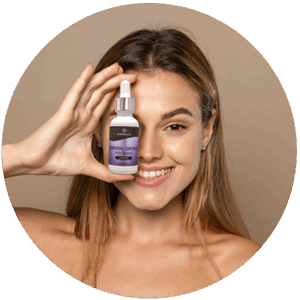 Hair thinning in midlife isn’t just “bad luck” or “getting older.” It’s a sign that your follicles are under stress — from inflammation, hormones, circulation changes, or toxin overload. The good news? Follicles are living tissue. With the right environment, they can often be coaxed back into healthier activity.
Hair thinning in midlife isn’t just “bad luck” or “getting older.” It’s a sign that your follicles are under stress — from inflammation, hormones, circulation changes, or toxin overload. The good news? Follicles are living tissue. With the right environment, they can often be coaxed back into healthier activity.
That’s why the best approach is holistic:
- Feed your body with the nutrients hair needs.
- Manage stress and prioritize sleep.
- Gently care for your scalp, as you would the skin on your face.
- Add targeted topical support to nourish follicles directly.
This is where a clean, well-formulated serum can make all the difference. By supporting circulation, calming the scalp, and protecting strands from breakage, it helps create the conditions for stronger, fuller, healthier-looking hair.
One option we’ve seen many readers have success with is EverBella’s Essential Growth Hair Serum. Made right here in the USA with 12 synergistic botanicals, including rosemary, peppermint, jojoba, castor, and vitamin E, it’s free from harsh preservatives, parabens, and endocrine disruptors. Just a few drops massaged into the scalp can help reawaken struggling follicles and protect your hair’s future.
And with EverBella’s generous 180-day money-back guarantee, you can try it risk-free and see if it’s right for you.
👉 Click here to learn more about EverBella’s Essential Growth Hair Serum.
Your hair deserves gentle care that works with your body, not against it. Start today, and give your follicles the support they’ve been waiting for.
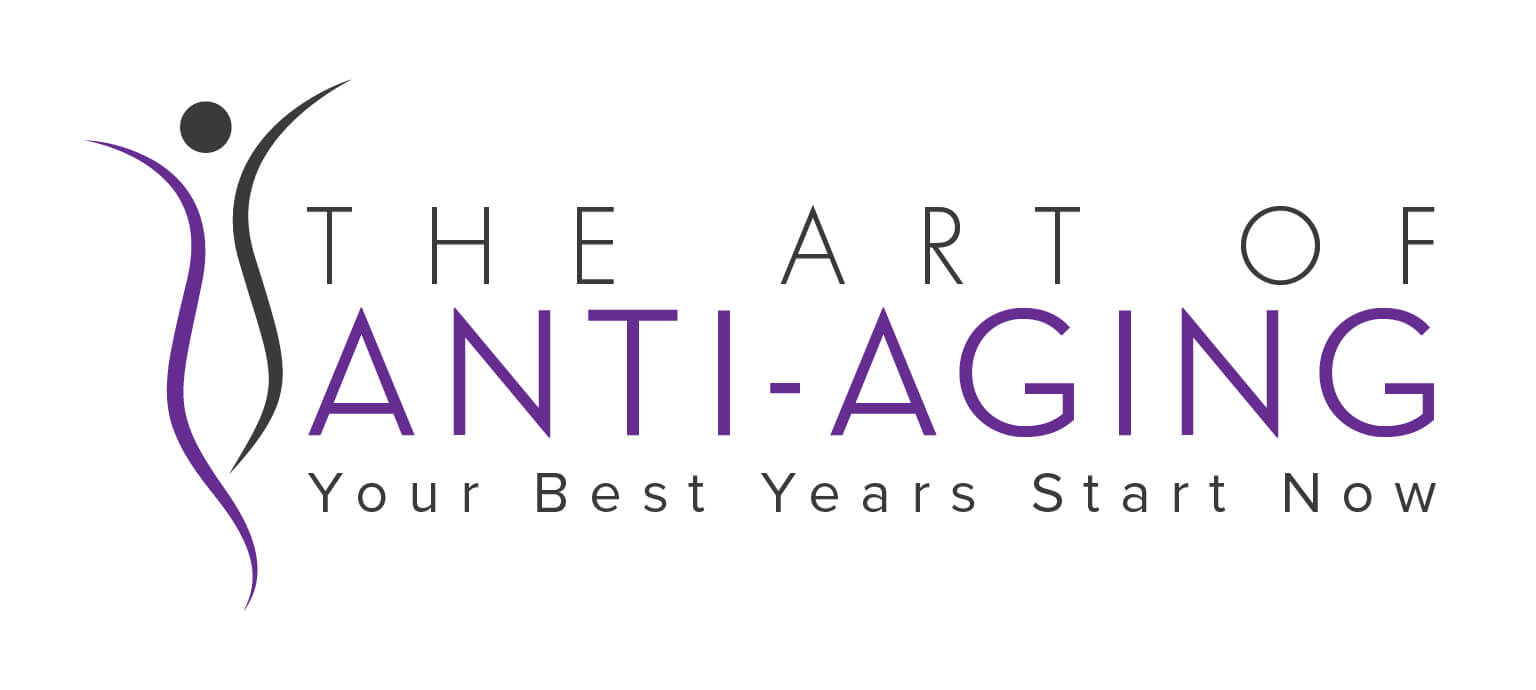
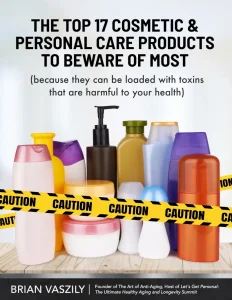
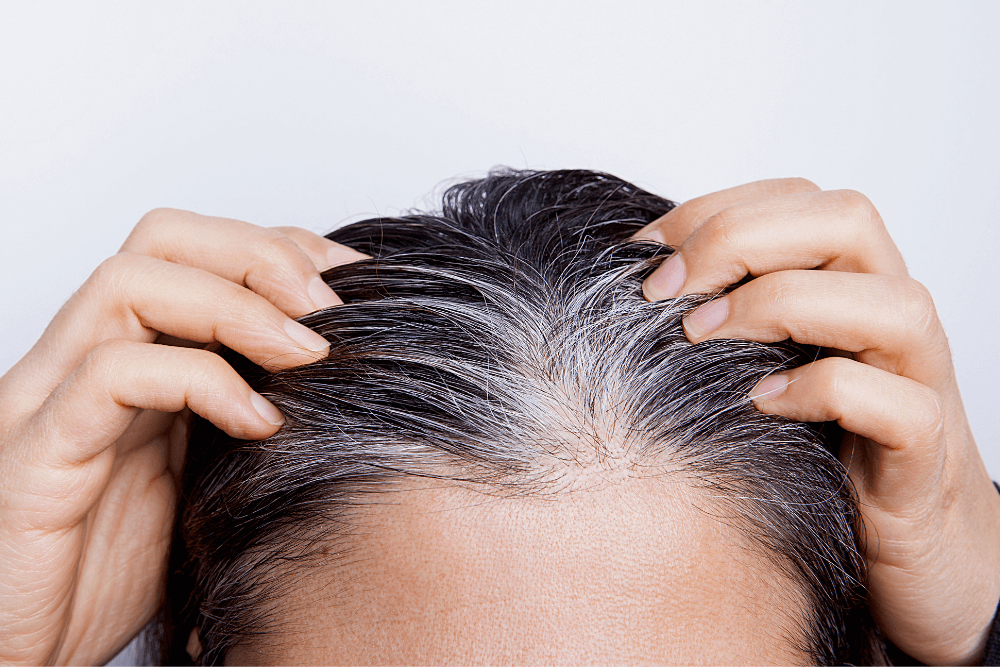
Thank you so very much for sharing this information! There are so many women and men who don’t understand the key reasons behind why hair loss and hair thinning come anout! This is so helpful and information that I can pass on to others! Thanks again for your commitment and dedication! 😊😊 God bless!